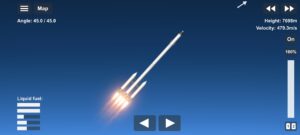Spaceflight simulator is a game for Android iOS and PC which gives you the ability to build and fly the spaceships of your dreams. In a recent update the developers added challenges to the otherwise pure sandbox game. As they can be quite hard for beginners to accomplish here is a guide to tick all moon achievements off the list.
Preparations
The first challenge is reaching low lunar orbit, technically specified as an orbit around the moon with a maximum distance of 100km to the surface. But before even entering the sphere of influence of the moon we of course need to leave the earth’s atmosphere first.
Moon rocket – Where is my Saturn V?
The rocket we will be using for all of the challenges is built only out of basic parts keeping it simple and easy to replicate. Furthermore all the moon challenges can be accomplished in one flight. You can download the blueprint for the rocket here and unzip it and then copy it into the saves/blueprint folder to proceed without needing to build the rocket yourself.



Reach low earth orbit
After building or downloading the rocket proceeds to launch to put it on the launch pad. Now activate the first stage by activating (tapping on it) all 4 of the first engines. Now crank the power up to 100% and turn the engines on. On your way to space follow the tilting guide to get into an earth orbit. Once the first stage has run out of liquid fuel separate it from the second stage and activate the engine once you crossed the karman line (80km height).



Fire the engine until you have reached a highly elliptical orbit around the earth that intersects with the moon orbit and speed the time up until your spacecraft will have an encounter with the moon. By tapping on the moon in the map view you are also able to select the navigate to option which will then show you when an encounter is coming up.



Enter moon orbit
Once you have entered the sphere of influence of the moon, fire your engines in the opposite direction of flight causing the spacecraft to slow down and enter a high moon orbit.
Challenge 1: Reach low lunar orbit
By firing the engines at the highest point of the orbit (Perigee) and lowest (Apogee) in the opposite direction of flight you can lower the orbit to a low orbit of around 20km around the moon. Descending so far doesn’t only allow for a more precise landing on the moon but as a side effect also gives you the first achievement of reaching low lunar orbit.
Challenge 2: Land on the moon surface
To finally land on the lunar surface you need to lower your theoretical orbit so much that it intersects with the moon surface. Ideally do this so that you will land on one of the landmarks such as the craters. Now speed forward until your spacecraft has reached a height of 5km. Now you need to perform a few carefull engine burns to equalize both of the speed arrows you can see next to your spacecraft to zero before you reach the surface. Here it is advised to first anulate the horizontal speed and then trim the engine power accordingly to softly touch down. Also remember to fold out the landing legs to reduce the risk of damaging the engine. Success! You have landed on a moon landmark.



Challenge 3: visit 3 landmarks on the moon
After successfully landing on the moon at the first landmark you can fire the engines of your rocket again an blast off to the next landmark. Always check the estimated trajectory in the map view to not overshot your landing site. After reaching a height of 5 km again simply repeat the steps from challenge 1 and land on the new landmark. Now redo everything for the last landmark.



Finish all challenges
To finish all challenges and get back to earth, blast of with your rocket into a low lunar orbit again. Then higher the orbit so much that you leave the sphere of influence of the moon and enter a high earth orbit. Now when reaching the Apoapsis of the orbit fire the engines and slow down so that the “orbit trajectory intersects” with the earth’s surface. Now speed up until about 120km before entering Earth’s atmosphere and separate the 3rd stage of the capsule. Proceed with entering the earth’s atmosphere by pointing the heatshield of the capsule always into the direction of flight, which is marked by the little arrow.



Should you not enter with the heatshield first in the atmosphere the capsule will get destroyed by the heat generated. Survived reentry?



Great, now wait until your capsule has reached a height of 1km above the surface and deploy the parachute by tapping on it once.
Congratulations, enjoy watching your spacecraft slowly descend back to it’s home planet after a long and successful space mission to the moon. By pressing recover you will get an overview of all the achievements of your tedious space adventure. Under these are, as expected, all the moon missions and as a side effect if you are lucky also all the earth missions.



Enjoy and thanks for flying with the GLPC space program.
Conclusion
As explained in detail in this tutorial, accomplishing all the moon challenges isn’t as difficult as it might seem on first glance. Have fun in spaceflight simulator and godspeed on your future rocket launches. Interested in other spaceflight themed games? Take a look at our Kerbal Spaceflight Review or the first look at the new Everspace 2.






Thank you for your sharing. I am worried that I lack creative ideas. It is your article that makes me full of hope. Thank you. But, I have a question, can you help me?
Thank you for your sharing. I am worried that I lack creative ideas. It is your article that makes me full of hope. Thank you. But, I have a question, can you help me?
I don’t think the title of your article matches the content lol. Just kidding, mainly because I had some doubts after reading the article.
Can you be more specific about the content of your article? After reading it, I still have some doubts. Hope you can help me.
Can you be more specific about the content of your article? After reading it, I still have some doubts. Hope you can help me.
Thank you for your sharing. I am worried that I lack creative ideas. It is your article that makes me full of hope. Thank you. But, I have a question, can you help me?
Your point of view caught my eye and was very interesting. Thanks. I have a question for you.